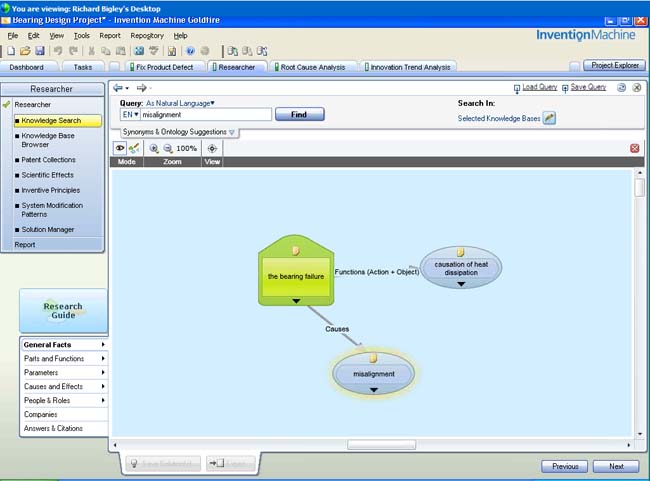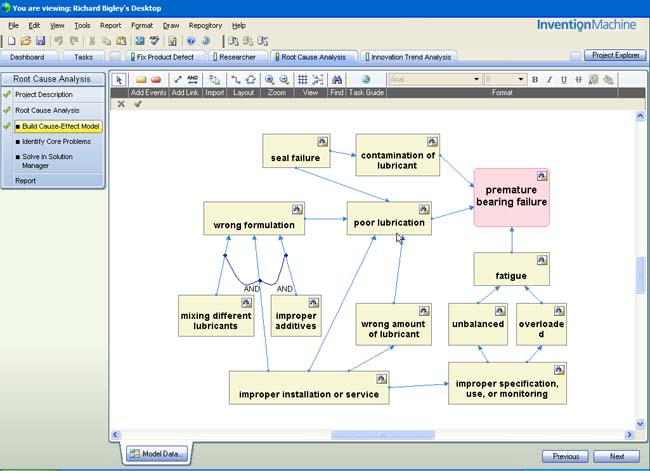Latest News
September 24, 2009
By Kenneth Wong
No software, however well thought-out, can possibly spit out a foolproof concept or a surefire idea, but if you’re thinking about bringing a new product to market, Boston-headquartered Invention Machine’s Goldfire software might give a way to take stock of the pros and cons of your upcoming invention or (at the very least) do a reality check.
If you define product lifecycle management (PLM) to include concept development and idea exploration (the brainstorming phase that often gets ignored), Goldfire fits into that front end. To potential inventors, or companies on the lookout for breakthrough inventions, Goldfire offers access to a wealth of patent literature past and present, as part of the knowledge repository you might consult before you charge headlong into development and production.
Fact Finding Mission
Suppose you’re looking into the possibility of developing a line of roller bearings that can better withstand the effects of corrosion, Goldfire gives you a guided workflow to check whether others have acquired patents on technologies applicable to this venture.
When you query Goldfire, you’re digging through worldwide patent records, online content from technical Web sites, pre-indexed content from the Instituteof Electrical and Electronics Engineers (IEEE), and corporate data (that is, emails and reports from your own organization that might yield clues about the viability of your idea).
Part of the software’s strength comes from Invention Machine’s patented semantic indexing technology. The company claims it enables “precision access to context-specific content.” Whereas a search engine query typically returns a list of sites but doesn’t always point you to the specific passage or sentence that addresses your topic of interest, Goldfire is designed to identify and highlight specific portions of the text where you’ll uncover something about your topic of interest, be it the root causes of roller bearing corrosion, the ergonomic benefits of a foldable box spring, or the design of a CPU that generates less heat.
Goldfire is supposed to be able to decipher natural language, so you can, in fact, type your query in not just as a series of keywords but as a question: For instance, “What are the common causes of roller bearing corrosion?” As with Google’s searches, if your query seems ambiguous, Goldfire gives you a series of choices, or educated guesses on what you’re looking for.
 Fig 1. As shown in the prompts above and below the query box visible here, Goldfire software is designed to interpret natural language queries. |
 Fig 2. The diagramming tools let you record and explore the relationships and dependencies among causes, effects, and potential fixes. |
The software’s diagram and schematic tools let you capture your findings and establish relationships among causes, effects, solutions, and issues related to each proposed solution. At each stage, you can choose to dig deeper into a certain topic with additional queries.
The software keeps track of other internal queries, thus alerting you of colleagues who might be looking into the same idea. Your findings and analyses can be packaged into a report, publishable in Word document to be shared with suppliers or management.
A Few Observations
From the look of the software, Invention Machine seems to have put a lot of thought into turning a wealth of public, proprietary, and personal knowledge into a searchable database for inventors and innovators. The software does not, however, rate or rank the indexed content; therefore, it’s up to the user—you—to judge the reliability of the assertions you discover (for example, “Grease-less lubrication will significantly reduce seal failure”) based on your engineering instinct, expertise, and the nature of the source document.
Though the software is well-designed for internal use, it currently has few features or tools to engage and identify potential collaborators in the public realm (as you might do using social media). While Invention Machine provides ways to integrate Goldfire with data from enterprise resource planning systems and other business software, it provides no easy way to interact with 3D product design files. This may not be a necessity if your product line is made of simple geometry (like spray paint cans), but if you’re doing root-cause analysis where the shape of the product is a major contributor (hearing devices or medical prosthetics, for example), the ability to index, archive, retrieve, and share 3D representations of your current ideas and previously discarded iterations is preferred—something that could be made possible by a partnership between Invention Machine and the developer of a lightweight CAD viewer.
Goldfire is ideal for manufacturers that want to take a disciplined approach to innovation (“sustainable innovation,” in Invention Machine’s words), a reliable way to track and evaluate the elusive ideas that might become tomorrow’s breakthrough products. But no software can replace good engineering instinct and thinking outside the box.
Invention Machine’s Goldfire was among Desktop Engineering editor at large Anthony Lockwood’s picks for noteworthy items. For more read his Editor’s Pick entry here.
Subscribe to our FREE magazine, FREE email newsletters or both!
Latest News
About the Author
Kenneth Wong is Digital Engineering’s resident blogger and senior editor. Email him at [email protected] or share your thoughts on this article at digitaleng.news/facebook.
Follow DE





